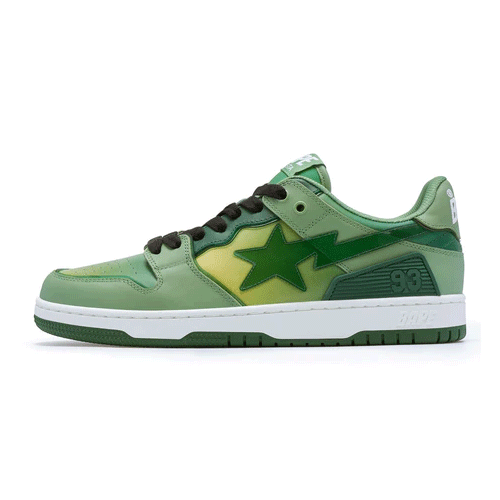If you’ve ever dipped your toes into sneaker culture or streetwear fashion, chances are you’ve heard the name Bapesta. Pronounced “Bape-sta,” this shoe is more than just a sneaker — it’s a cultural landmark. Created by Japanese streetwear brand A Bathing Ape (BAPE), the Bapesta stands tall alongside other legendary silhouettes like the Air Force 1, Jordan 1, and Yeezy. But what makes the Bapesta so iconic, and why has it continued to thrive in an increasingly crowded sneaker landscape? Let’s take a closer look.
The Origins of Bapesta: A BAPE Revolution
To understand the significance of the Bapesta, we first need to understand its creator — A Bathing Ape. Founded in 1993 by designer and entrepreneur Nigo, BAPE was Japan’s answer to the growing demand for Western streetwear. Heavily influenced by hip-hop, skate culture, and American fashion, Nigo created a brand that quickly rose to prominence not only in Japan but globally.
The Bapesta made its debut in the early 2000s and was instantly recognizable for its striking resemblance to Nike’s Air Force 1. The silhouette was nearly identical, but BAPE put its own twist on it — replacing the Swoosh with the iconic star-shaped “STA” logo, using glossy patent leather, and dropping colorways that screamed individuality. From camo prints to neon hues, the Bapesta was unapologetically bold.
The Sneaker’s Design: Loud, Luxurious, and Limitless
The Bapesta is not a sneaker that plays it safe. Its most famous versions are often dipped in bright colors, shiny patent finishes, and wild graphics. Unlike traditional sneaker brands that offered performance-first products, BAPE saw sneakers as an extension of personal style — an accessory as expressive as a graphic tee or designer bag.
Even the materials were a standout. Bapestas often used high-gloss patent leather, something uncommon in mainstream sneakers at the time. The textures, color combinations, and premium packaging helped establish the Bapesta as a luxury item, not just footwear. Each pair felt like a collectible, which added to its mystique and demand.
The Celebrity Co-Sign: Fueling Hype Before Instagram
Before influencer marketing became a formal strategy, the Bapesta had already mastered it. Nigo, deeply connected to the music world, collaborated with major hip-hop artists like Pharrell Williams, Kanye West, and Soulja Boy. Pharrell even partnered with Nigo to launch Billionaire Boys Club and Ice Cream — brands that were often seen in tandem with Bapestas.
These celebrities wore Bapestas in music videos, red carpets, and album covers. Kanye West famously had his own Bapesta colorway, complete with a “Dropout Bear” design — a nod to his College Dropout album. Soulja Boy’s viral hit “Crank That” even name-dropped Bapestas, cementing them into early 2000s pop culture.
In an era before Instagram, this level of organic exposure made the Bapesta incredibly desirable. You weren’t just wearing a shoe — you were participating in a movement.
Cultural Influence: Bapesta’s Global Impact
Though BAPE originated in Japan, the Bapesta helped the brand achieve global streetwear dominance. It served as a bridge between Eastern and Western fashion sensibilities. In the United States, it resonated deeply with fans of hip-hop and street culture. In Europe and Asia, it represented the rare intersection of exclusivity and global cool.
What made Bapesta truly unique was its ability to remain relevant across different subcultures. Whether you were into hip-hop, skateboarding, anime, or fashion, there was a version of the Bapesta that spoke your language. And because BAPE frequently released limited-edition drops, owning a pair felt like being part of an elite club.
Bapesta and the Sneaker Resale Market
As sneaker culture grew, so did the resale market — and Bapestas became a hot commodity. Limited supply, celebrity collaborations, and distinctive designs meant that certain pairs could fetch hundreds or even thousands of dollars on platforms like StockX or GOAT.
This resale culture only elevated the mystique surrounding the Bapesta. Much like Air Jordans or Yeezys, these shoes became status symbols. Rocking a rare pair wasn’t just about fashion; it was a flex of cultural capital.
Even older models, especially those from the early 2000s, are now considered vintage and highly collectible. As nostalgia kicks in and Y2K fashion makes a comeback, those original glossy Bapestas are back in style — and more valuable than ever.
Bapesta’s Comeback and Modern Appeal
In recent years, BAPE has made a strong push to revitalize the Bapesta. New collaborations with brands like Coach, Marvel, and even Reebok have reintroduced the sneaker to a new generation. The updated models come with improved materials, better fit, and a wider range of colorways, but the essence of the original remains intact.
What’s impressive is how the Bapesta has evolved without losing its identity. The brand has stayed true to its roots — playful design, high quality, and cultural relevance — while also adapting to modern tastes. With the resurgence of early 2000s fashion and the rise of archival sneaker collecting, the Bapesta is once again at the forefront of streetwear.
Styling the Bapesta: Making a Statement in 2025
Today, wearing Bapestas is about making a statement. Whether you’re pairing them with cargo pants, an oversized hoodie, or a tailored streetwear look, they command attention. Their bold colors and graphic elements make them the centerpiece of any outfit.
The key to styling them in 2025 lies in balance. Because the shoes are loud, many fashion-savvy wearers opt for neutral or monochrome outfits that let the sneakers shine. Alternatively, you can go full maximalist — clashing patterns and bright layers — in true BAPE fashion.
In any case, Bapestas remain one of the few sneakers that are as much about art as they are about wearability.
How Bapesta Compares to Other Iconic Sneakers
It’s impossible to discuss Bapestas without acknowledging their similarities to the Nike Air Force 1. The silhouette has drawn both admiration and controversy, especially when BAPE first launched the sneaker. Nike reportedly took legal action in the past, although BAPE has since adjusted its newer models to differentiate more clearly.
Still, comparisons aside, Bapesta has earned its place in sneaker history. While the Air Force 1 may have originated the look, the Bapesta elevated it with cultural storytelling, limited editions, and artistic flair that made it more than just a copy — it became a reinterpretation.
What’s Next for Bapesta?
Looking ahead, the future of Bapesta seems promising. With collaborations continuing to drop and the brand re-engaging with both legacy fans and younger audiences, BAPE is once again a mainstay in streetwear culture.
As sustainability becomes a growing concern in fashion, it will be interesting to see how BAPE adapts. Whether it’s through more eco-conscious materials or digital releases like NFTs and virtual fashion, the next evolution of Bapesta will likely blend innovation with nostalgia.
One thing is certain: Bapesta is not just a sneaker. It’s a symbol — of youth, rebellion, creativity, and global style. And as long as fashion continues to cycle and evolve, Bapesta will always have a seat at the table.
Final Thoughts
The Bapesta is more than a fashion statement — it’s a cultural icon that has defined and redefined streetwear over the past two decades. Its journey from Tokyo boutiques to global runways, rap lyrics, and sneaker rotations is a testament to its timeless appeal.
For sneakerheads, fashion enthusiasts, and streetwear lovers alike, Bapesta remains a grail-worthy piece. Whether you’re rocking a vintage pair or a new drop, one thing’s clear: when you wear Bapesta, you’re not just following trends — you’re creating them.


